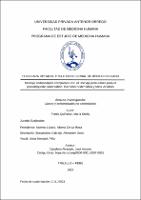Mostrar el registro sencillo del ítem
Drenaje endoscópico comparado con el Drenaje percutáneo para el pseudoquiste pancreático: Revisión Sistemática y Meta-Análisis
| dc.contributor.advisor | Caballero Alvarado, José Antonio | |
| dc.contributor.author | Flores Quiñonez, María Shelly | |
| dc.creator | Flores Quiñonez, María Shelly | |
| dc.date.accessioned | 2023-12-07T15:32:28Z | |
| dc.date.available | 2023-12-07T15:32:28Z | |
| dc.date.issued | 2023 | |
| dc.identifier.uri | https://hdl.handle.net/20.500.12759/14112 | |
| dc.description.abstract | Objetivo: Determinar cuál es la eficacia y seguridad del drenaje endoscópico comparado con el drenaje percutáneo en el tratamiento del pseudoquiste pancreático. Material y métodos: Revisión sistemática y metaanálisis, donde se utilizó las bases de datos PubMed, Web of Science, Scopus y OvidMEDLINE, obteniendo 942 artículos. Dichos artículos se almacenaron en el software Rayyan para tamizaje y evaluación, acorde a la guía PRISMA 2020. Los datos relevantes se registraron en el programa Microsoft Excel 2019. Finalmente, se realizó la síntesis de la evidencia a través del software Review Manager 5.4.1. Resultados: En la síntesis cualitativa y cuantitativa se incluyeron 4 estudios. El drenaje endoscópico reduce un 37% el fracaso terapéutico (RR 0.63; IC del 95%: 0.02-0.91; p = 0.01) frente al drenaje percutáneo. Con respecto a la reintervención, el drenaje endoscópico disminuye un 69% (RR 0.31; IC del 95%: 0.19-0.49; p < 0.00001). Las complicaciones no presentaron diferencia significativa entre ambos drenajes, pero sí hubo tendencia a favor del drenaje endoscópico (RR 0.72; IC del 95%: 0.43-1.20; p = 0.07). En cuanto a la mortalidad, el drenaje endoscópico reduce un 90% (RR 0.10; IC del 95%: 0.01-0.87; p = 0.04). Por último, para la duración de estancia hospitalaria fue a favor del drenaje endoscópico, demostrando menor tasa (MD -25.03; IC del 95%: -42.01- 8.05; p = 0.004). Conclusiones: Las complicaciones no mostraron una diferencia estadísticamente significativa entre ambos grupos de drenaje para el manejo de los pseudoquistes pancreáticos. Sin embargo, en relación al fracaso terapéutico, la tasa de reintervención, mortalidad y duración de estancia hospitalaria, la intervención endoscópica demostró ser más eficaz y segura que la percutánea | es_PE |
| dc.description.abstract | Objective: To determine the efficacy and safety of endoscopic drainage compared to percutaneous drainage in the treatment of pancreatic pseudocyst. Material and methods: Systematic review and meta-analysis, using PubMed, Web of Science, Scopus and OvidMEDLINE databases, obtaining 942 articles. These articles were stored in Rayyan software for screening and evaluation, according to the PRISMA 2020 guidelines. Relevant data were recorded in Microsoft Excel 2019. Finally, the evidence was synthesized using Review Manager 5.4.1 software. Results: Four studies were included in the qualitative and quantitative synthesis. Endoscopic drainage reduces therapeutic failure by 37% (RR 0.63; 95% CI 0.02-0.91; p = 0.01) compared to percutaneous drainage. With respect to reoperation, endoscopic drainage reduces by 69% (RR 0.31; 95% CI: 0.19-0.49; p < 0.00001). Complications did not show a significant difference between both drains, but there was a trend in favor of endoscopic drainage (RR 0.72; 95% CI: 0.43-1.20; p = 0.07). Regarding mortality, endoscopic drainage reduces 90% (RR 0.10; 95% CI: 0.01-0.87; p = 0.04). Finally, for the length of hospital stay, it was in favor of endoscopic drainage, demonstrating a lower rate (MD -25.03; 95% CI: -42.01- 8.05; p = 0.004). Conclusions: Complications did not show a statistically significant difference between both drainage groups for the management of pancreatic pseudocysts. However, in relation to therapeutic failure, reoperation rate, mortality and length of hospital stay, endoscopic intervention proved to be more effective and safer than percutaneous intervention. | es_PE |
| dc.description.uri | Tesis | es_PE |
| dc.format | application/pdf | es_PE |
| dc.language.iso | spa | es_PE |
| dc.publisher | Universidad Privada Antenor Orrego | es_PE |
| dc.relation.ispartofseries | T_MED_3608 | |
| dc.rights | info:eu-repo/semantics/openAccess | es_PE |
| dc.rights.uri | https://creativecommons.org/licenses/by/4.0/ | es_PE |
| dc.source | Universidad Privada Antenor Orrego | es_PE |
| dc.source | Repositorio Institucional | es_PE |
| dc.subject | Drenaje endoscópico | es_PE |
| dc.subject | Drenaje percutáneo | es_PE |
| dc.subject | Pseudoquiste pancreático | es_PE |
| dc.title | Drenaje endoscópico comparado con el Drenaje percutáneo para el pseudoquiste pancreático: Revisión Sistemática y Meta-Análisis | es_PE |
| dc.type | info:eu-repo/semantics/bachelorThesis | es_PE |
| thesis.degree.grantor | Universidad Privada Antenor Orrego. Facultad de Medicina Humana | es_PE |
| thesis.degree.name | Médico Cirujano | es_PE |
| thesis.degree.discipline | Medicina Humana | es_PE |
| dc.subject.ocde | http://purl.org/pe-repo/ocde/ford#3.02.27 | es_PE |
| renati.advisor.orcid | https://orcid.org/0000-0001-8297-6901 | es_PE |
| renati.author.dni | 70465426 | |
| renati.advisor.dni | 18886226 | |
| renati.type | http://purl.org/pe-repo/renati/type#tesis | es_PE |
| renati.level | http://purl.org/pe-repo/renati/level#tituloProfesional | es_PE |
| renati.discipline | 912016 | es_PE |
| renati.juror | Moreno Lázaro, Alberto De La Rosa | |
| renati.juror | Bustamante Cabrejo, Alexander David | |
| renati.juror | Urcia Bernabé, Félix | |
| dc.publisher.country | PE | es_PE |
Ficheros en el ítem
Este ítem aparece en la(s) siguiente(s) colección(es)
-
Medicina Humana [2765]




